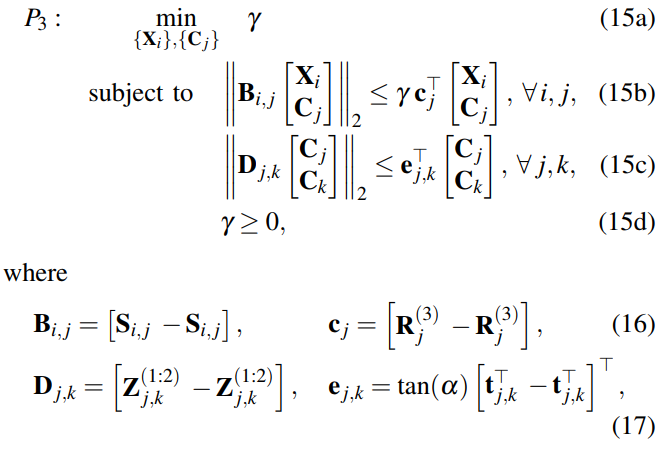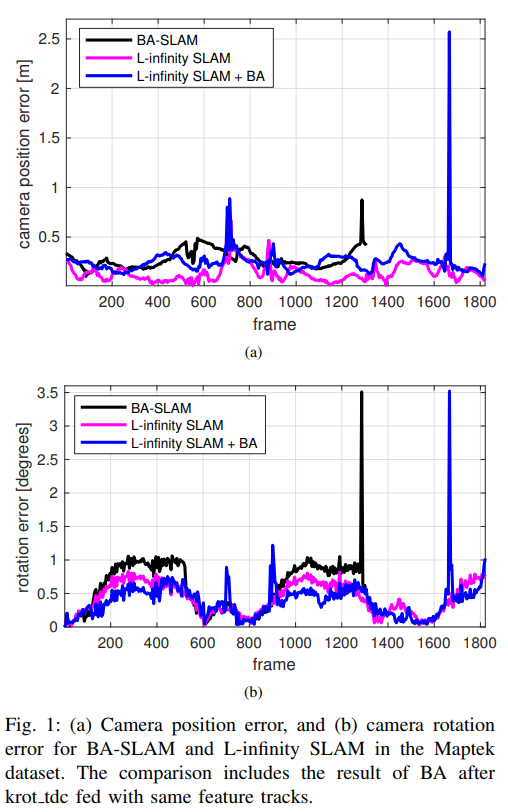【論文】「Visual SLAM: Why Bundle Adjust?」を読む【ICRA2019】
はじめに
興味をもったきっかけは以下のtweetです。
本論文ではvSLAMの新しい最適化手法を提案. 従来の最適化手法(BA)で手がかりとしていた3D地図を使わず, カメラの方向のみを使って最適化するため, BAが抱えていた複雑さが解消され, カメラの動きによりロバストなSLAMを実現した.https://t.co/EIjImeKi1L pic.twitter.com/TqbkMWnTAl
— まさや (@syinari0123) 2019年2月12日
vSLAMはSLAMの中でも更に全然わからないのですが、バンドル調整(Bandle Adjustment)(某界隈でBAと略すらしい)を使ってないのは興味深いです。なので、論文を読むことにしました。
気合で一通り目を通しましたが、軽い気持ちで読むんじゃなかったと後悔しました。
[1902.03747] Visual SLAM: Why Bundle Adjust?
概要
バンドル調整に基づくSLAMの問題点
- バンドル調整を慎重に初期化する必要があり、複雑。
- (十分なベースラインが必要なので、)スローモーションまたは純粋な回転モーションが苦手 。
提案手法
バンドル調整の代わりに、カメラの向きだけを徐々に最適化するために回転の平均化(rotation averaging)を行う。
提案手法により、位置と三次元地図をキーフレームレートで推定および維持する必要がなくなるだけでなく(よりシンプルなSLAMシステムになるだけでなく)、
スローモーションや純粋な回転モーションにも対応できるようになる。
本文
序論
従来のBA(Bandle Adjustment) SLAM

ここで、
ui, j is the 2D coordinates of the i-th scene point as seen in the j-th image Zj.
structure-from-motion (SfM) aims to estimate the 3D coordinates X = {Xi} of the scene points and 6DOF poses {(Rj,tj)} of the images {Zj}.
bundle adjustment (BA) formulation

提案手法 L-INFINITY SLAM

rotation averaging formulation
Given a set of relative rotations {Rj,k} between pairs of overlapping images {Zj ,Zk}, the goal of rotation averaging is to estimate the absolute rotations {Rj}


Unlike (1) which minimises the sum of squared reprojection error,
(4) minimises the maximum reprojection error.
アルゴリズム詳細
A. Estimating relative motions
Rj,k はrotationally aligning backprojected feature rays by using a rotation only variant of Trimmed ICPで推定している。
B. Rotation averaging
式(3)を解くために an iteratively reweighted least-squares approach in SO(3)を使用。
C. Known rotation problem
By referring to R(1:2)j as the first two rows of Rj, and to R(3)j
as the third row of Rj (similarly for t(1:2) and t(3)), the projection of Xi onto the j-th image is given by

式(6)を式(4)に適用し式変形すると、以下の最適化問題になる。


これをRes-Intと呼ばれる方法で解く。Res-Intはこの問題を about 3 seconds for moderate size input (around 15 images and 3000
3D points)で解く。
Res-Int はLine 5 in Algorithm 2の the known rotation prob routine に当たる。
D. Known rotation(KRot) problem with translation direction constraints
ループが検出される時入力サイズは大きくなるので、Step 9 in Algorithm 2のKRotを解くには非常に時間がかかる。
そこで、カメラの並進方向を組み込んだ定式化を使用して、入力のサンプルに対するループクロージャを解決することを提案する。
カメラ位置の制約は以下で表わせられる。

式(12)はKnown rotation problem において式(13)の角度制約に一致する。

Known rotation problemに角度制約を追加すると以下が導出される。
これによりスパースな3D点集合を用いてループクロージャ(<100秒)を効率的に解くことが可能になる。

ここでZj,kは以下のような回転行列である。

結果
誤差低減
従来のBandle Adjustmentだとトラッキングに失敗している箇所がある。
軌跡が滑らかに

実行時間の高速化

読むときに参考にした資料
vSLAMの勉強用
SLAM勉強会(PTAM)
本論文を読むきっかけその2。カメラの動きの遅いという仮定の下カメラの位置姿勢しているのが面白いと思った。LSD-SLAM: Large-Scale Direct Monocular SLAM - Daily Tech Blog
論文理解用
- 群論の軽い説明
上の記事でリー代数のお気持ちを理解した。(その他、リー代数の本や記事を少々読んだ) - Min-Max 計画法-理 論 と計算方法 - J-Stage
式(4)の変形を理解するのに読んだ。
今後の読むべき論文
- rotation averagingの論文
- Res-Intの論文
追記
解説スライドを挙げてくれた方がいたので、追記しときます。
Visual SLAM: Why Bundle Adjust?の解説(第4回3D勉強会@関東)